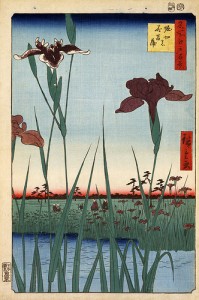So, drowning turkey chicks: is it a rural myth? Have your say.
Bulgaria’s Rose Valley in trouble
Almost half the expensive rose oil used in perfumes and cosmetics comes from a single valley in Bulgaria.
Let the BBC tell you all about it.
Iris in Japan and Tuscany
We went to the Hirishoge exhibition here in Rome some time ago, and very impressive it was too, but I don’t remember seeing this particular woodcut.

I’ve in fact only just come across it, on Flickr, where there is this fascinating commentary:
In the village of Horikiri in suburban Edo, gardeners grew a year-round variety of flowers and were particularly famous for the iris shown here, “hanashobu,” well suited to this swampy land. In this print Hiroshige has shown three, almost-life-size, detailed specimens of the nineteenth-century hanashobu hybrids and in the distance, sightseers from Edo are admiring the blossoms. In the 1870’s the cultivation of hanashobu had begun to spread rapidly in Europe and America and the developed into a booming export market for the gardeners of Horikiri. The Horikiri plantations began to wane in the 1920’s and eventually turned over to wartime food production. After the war, one of them was revived and is now a public park, particularly popular in May when the flowers are in bloom.
Breadfruit goes mainstream
Well I must say I never thought breadfruit would make it to Newsweek, but it has. Well done, Diane!
Making changes
Changemakers is a community of action where we all collaborate on solutions. We know we have the power to solve the world’s most pressing social problems. We’re already doing it, one project, one idea at a time.
How do we do it? We talk about the issues, share stories and mentor, advise, and encourage each other in group forums, even engage in friendly competition. We form surprising connections and unexpected partnerships across the globe that turn the old ways of problem solving upside down. We try things that have never been tried before.
With regard to the competitions, the winners of the one entitled “Cultivating Innovation: Solutions for Rural Communities,” which “aims to find innovative solutions toward improving the quality of life in rural and farming communities,” were announced a few days ago. Alas, none of the three winners, worthy as they undoubtedly are, has an explicit agrobiodiversity focus. But I may be wrong, the descriptions of the projects are rather brief. The entry from the Uganda Rural Development and Training Programme, for example, mentions seed saving.
The latest competition is all about GMOs: “How can we help consumers make better, more informed choices?” You can join the debate, or submit an entry, here. The winner will get a chance to chat with the best-selling author of The Omnivore’s Dilemma and In Defense of Food, Michael Pollan. There are six weeks left to enter. If you have a new, innovative way to “help consumers become more aware of what they are eating, and discover how their choices will affect health, the environment and society,” have a go!